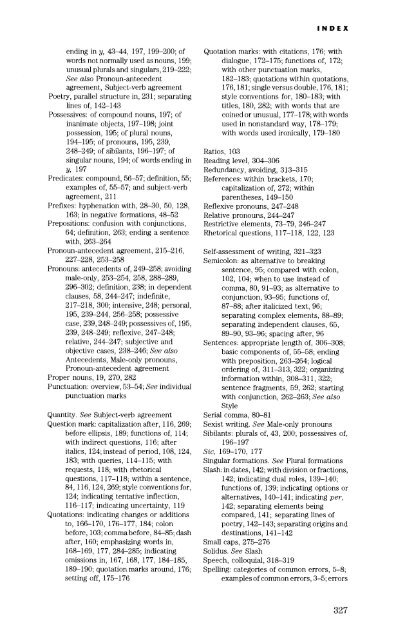Grammatically Correct: The writer's essential guide to punctuation ...
Grammatically Correct: The writer's essential guide to punctuation ...
Grammatically Correct: The writer's essential guide to punctuation ...
Create successful ePaper yourself
Turn your PDF publications into a flip-book with our unique Google optimized e-Paper software.
ending in y, 43-44, 197, 199-200; of<br />
words not normally used as nouns, 199;<br />
unusual plurals and singulars, 219-222;<br />
See also Pronoun-antecedent<br />
agreement, Subject-verb agreement<br />
Poetry, parallel structure in, 231; separating<br />
lines of, 142-143<br />
Possessives: of compound nouns, 197; of<br />
inanimate objects, 197-198; joint<br />
possession, 195; of plural nouns,<br />
194-195; of pronouns, 195, 239,<br />
248-249; of sibilants, 196-197; of<br />
singular nouns, 194; of words ending in<br />
y, 197<br />
Predicates: compound, 56-57; definition, 55;<br />
examples of, 55-57; and subject-verb<br />
agreement, 211<br />
Prefixes: hyphenation with, 28-30, 50, 128,<br />
163; in negative formations, 48-52<br />
Prepositions: confusion with conjunctions,<br />
64; definition, 263; ending a sentence<br />
with, 263-264<br />
Pronoun-antecedent agreement, 215-216,<br />
227-228, 253-258<br />
Pronouns: antecedents of, 249-258; avoiding<br />
male-only, 253-254, 258, 288-289,<br />
296-302; definition, 238; in dependent<br />
clauses, 58, 244-247; indefinite,<br />
217-218, 300; intensive, 248; personal,<br />
195, 239-244, 256-258; possessive<br />
case, 239, 248-249; possessives of, 195,<br />
239, 248-249; reflexive, 247-248;<br />
relative, 244-247; subjective and<br />
objective cases, 238-246; See also<br />
Antecedents, Male-only pronouns,<br />
Pronoun-antecedent agreement<br />
Proper nouns, 19, 270, 282<br />
Punctuation: overview, 53-54; See individual<br />
<strong>punctuation</strong> marks<br />
Quantity. See Subject-verb agreement<br />
Question mark: capitalization after, 116, 269;<br />
before ellipsis, 189; functions of, 114;<br />
with indirect questions, 116; after<br />
italics, 124; instead of period, 108, 124,<br />
183; with queries, 114-115; with<br />
requests, 118; with rhe<strong>to</strong>rical<br />
questions, 117-118; within a sentence,<br />
84, 116, 124, 269; style conventions for,<br />
124; indicating tentative inflection,<br />
116-117; indicating uncertainty, 119<br />
Quotations: indicating changes or additions<br />
<strong>to</strong>, 166-170, 176-177, 184; colon<br />
before, 103; comma before, 84-85; dash<br />
after, 160; emphasizing words in,<br />
168-169, 177, 284-285; indicating<br />
omissions in, 167, 168, 177, 184-185,<br />
189-190; quotation marks around, 176;<br />
setting off, 175-1 76<br />
INDEX<br />
Quotation marks: with citations, 176; with<br />
dialogue, 172-175; functions of, 172;<br />
with other <strong>punctuation</strong> marks,<br />
182-183; quotations within quotations,<br />
176, 181; single versus double, 176, 181;<br />
style conventions for, 180-183; with<br />
titles, 180, 282; with words that are<br />
coined or unusual, 177-1 78; with words<br />
used in nonstandard way, 178-179;<br />
with words used ironically, 179-180<br />
Ratios, 103<br />
Reading level, 304-306<br />
Redundancy, avoiding, 313-315<br />
References: within brackets, 170;<br />
capitalization of, 272; within<br />
parentheses, 149-150<br />
Reflexive pronouns, 247-248<br />
Relative pronouns, 244-24 7<br />
Restrictive elements, 73-79, 246-247<br />
Rhe<strong>to</strong>rical questions, 117-118, 122, 123<br />
Self-assessment of writing, 321-323<br />
Semicolon: as alternative <strong>to</strong> breaking<br />
sentence, 95; compared with colon,<br />
102, 104; when <strong>to</strong> use instead of<br />
comma, 80, 91-93; as alternative <strong>to</strong><br />
conjunction, 93-95; functions of,<br />
87-88; after italicized text, 96;<br />
separating complex elements, 88-89;<br />
separating independent clauses, 65,<br />
89-90, 93-96; spacing after, 96<br />
Sentences: appropriate length of, 306-308;<br />
basic components of, 55-58; ending<br />
with preposition, 263-264; logical<br />
ordering of, 311-313, 322; organizing<br />
information within, 308-311, 322;<br />
sentence fragments, 59, 262; starting<br />
with conjunction, 262-263; See also<br />
Style<br />
Serial comma, 80-81<br />
Sexist writing. See Male-only pronouns<br />
Sibilants: plurals of, 43, 200; possessives of,<br />
196-197<br />
Sic, 169-170, 177<br />
Singular formations. See Plural formations<br />
Slash: in dates, 142; with division or fractions,<br />
142; indicating dual roles, 139-140;<br />
functions of, 139; indicating options or<br />
alternatives, 140-141; indicating per,<br />
142; separating elements being<br />
compared, 141; separating lines of<br />
poetry, 142-143; separating origins and<br />
destinations, 141-142<br />
Small caps, 275-276<br />
Solidus. See Slash<br />
Speech, colloquial, 318-319<br />
Spelling: categories of common errors, 5-8;<br />
examples of common errors, 3-5; errors<br />
327
















